Read The
Current Issue
Pedal On
Biking has become BIG in the Tetons.
By Molly Absolon
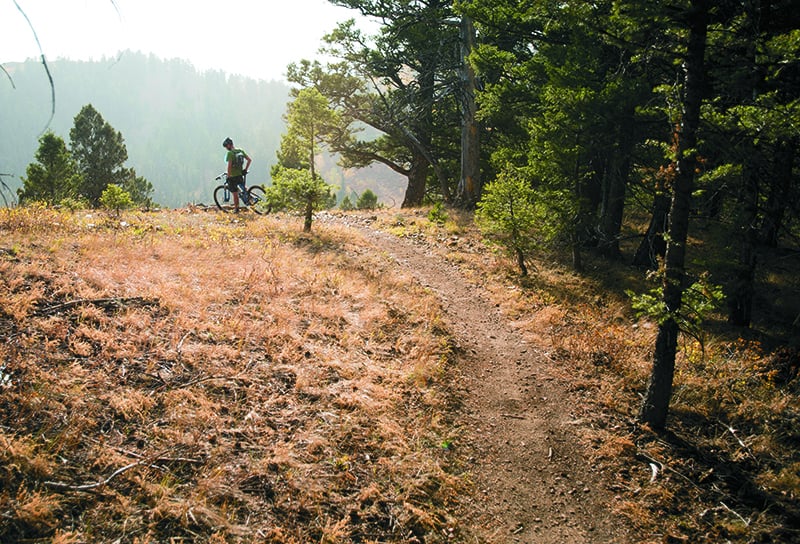
Photo by Bradly J. Boner
THE FIRST PAVED pathwayin Jackson Hole was built in 1996. That 4-mile section of asphalt connected neighborhoods in West Jackson with High School Road and gave kids a safe way to ride their bikes to school. The only mountain bike trails you could find in those days were converted hiking routes that tended to head straight up and straight down, meaning that only a mighty few could actually ride their bikes over many sections.
But those days are long gone. Today you can ride from downtown Jackson to Jenny Lake in Grand Teton National Park (GTNP) along what is arguably the most scenic bike path in the country. On the Idaho side of the Tetons, an 8-mile paved bike path connects the towns of Victor and Driggs, while further north, the old railroad grade for the Teton Valley Branch of the Union Pacific Railroad has been converted into a 30-mile gravel path that connects Tetonia and Ashton. It passes over three historic trestle bridges while winding through fields of barley rimmed by the western foothills of the Teton Range.
And then there are mountain bike trails. In Jackson Hole there are trail networks in East Jackson, on Teton Pass, and south of Wilson. In Teton Valley, Idaho, there are trails east of Victor, in the Big Hole Mountains, and in Horseshoe Canyon. Both Jackson Hole Mountain Resort and Grand Targhee Resort have miles of cross-country and downhill trails accessed via lifts.
All these options can be overwhelming, and visitors to the area may want to consider taking a guided bike tour, something else you couldn’t find around here 20 years ago. Now several companies lead rides, from leisurely tours on the bike paths in GTNP to rugged mountain bike rides in the Bridger-Teton National Forest (BTNF).
It used to be said that Jackson was a skier’s town with biking, but that’s changing quickly as more and more people take up cycling. Read on to discover how it’s changed and how to enjoy the changes.

The Right Path
Jackson Hole might have one of the best pathway systems in the country.
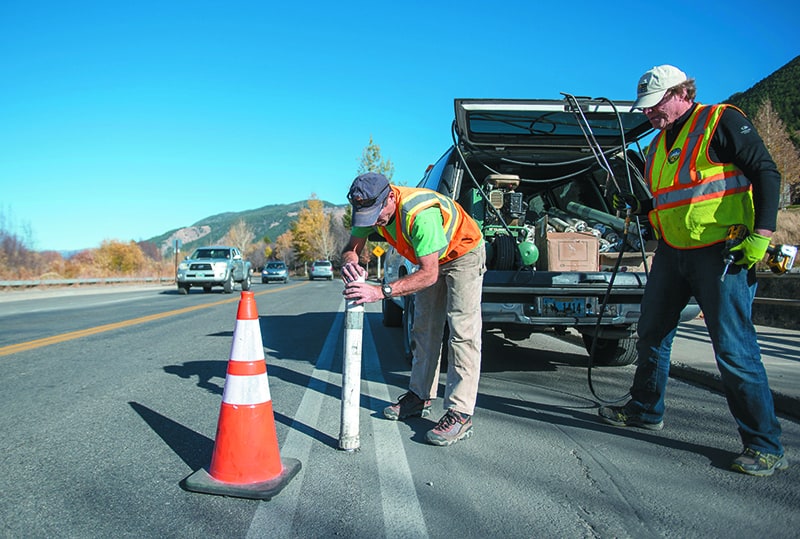
Jackson Hole Community Pathways Coordinator Brian Schilling and Friends of Pathways Program Director Jack Koehler remove the bollards separating bike lanes and vehicle traffic last fall on Snow King Avenue. Schilling said the project was meant as an inexpensive, impermanent trial run for protected bike lanes along the busy thouroughfare. Photo by Bradly J. Boner
JACKSON’S FIRST PAVED pathway, the Garaman Path—a 4-mile separated trail connecting the Jackson Hole High School to neighborhoods in West Jackson—was built in 1996. Since then the Town of Jackson and Teton County have constructed 53 more miles and Grand Teton National Park has added 16 miles. But these pathways—which are extremely popular (user counts taken along the Garaman Path in 2018 showed 173,000 trips that year)—weren’t always seen as a good way to spend money. (Biking is just one of the many uses the pathways see. The 2018 Garaman Path count found 112,000 bikers and 61,000 people on foot, whether running, walking, or rollerblading.)
Pathways are funded by Specific Purpose Excise Taxes (SPET), town and county capital funds, federal money and grants, lodging tax income, and private donations. Since 1996, about $35 million have been spent on pathways. The original pathway was the result of years of careful planning led by then-pathways coordinator for the county Tim Young. According to today’s pathways coordinator, Brian Schilling, Young’s plan was strategic and insightful. “Tim picked something small enough to get it done,” Schilling says, “Yet large enough to make a difference.” The Garaman Path’s success was easily demonstrable, and quickly won support for pathways, according to Schilling.
TWO BICYCLE-MOTOR vehicle crashes helped pathways gain additional momentum. In 1999, 13-year-old Gabriella Axelrad was struck and killed by a van while riding her bike in GTNP. The driver was changing a CD and never saw the young girl despite the fact that she had an orange flag on her bike and was riding in a group. Two years later, Jackson resident Jeff Poole was killed by a car while riding his bicycle along US Highway 89 just south of GTNP’s Moose entrance. “Gabriella was doing everything right, and still she died. Jeff was on a section of road that was supposed to be for shared use, and he was killed,” Schilling says. “Gabriella and Jeff died because of inadequate infrastructure and driver inattention.”
Many in the Jackson area saw Poole and Alexrad’s deaths as a wake-up call and began demanding more separated paths for cyclists. But there was some pushback. “There was this thing called ‘pathway fatigue,’ ” says program director for Friends of Pathways (FOP) Jack Koehler. “People questioned why we were building all these pathways, saying they are just for an elite group.” Schilling says there are people in the community who oppose pathways on principle. These people believe it is not the role of government to build separated bike and walking paths. But the fans outnumber pathway opponents: Local voters continue to pass SPET taxes that fund new pathways and repairs to existing pathways.
Additional proof for pathways’ popularity is the fact that in 2018 Friends of Pathways received more than 500 gifts through the annual community-wide fundraiser Old Bill’s Fun Run for Charities. “That made us one of the top two organizations after [Teton County] Search and Rescue,” says Lauren Dickey, FOP’s communications director. Future plans for pathways around Jackson Hole include creating a paved pathway over Teton Pass that will connect Old Pass Road to pathways in Idaho. In the long run the dream is to have a pathway that creates a loop through Yellowstone National Park from Jackson.

Dedicated Commuters
Neither snow, rain, heat, or cold stops the Smith siblings from riding their bikes to school.
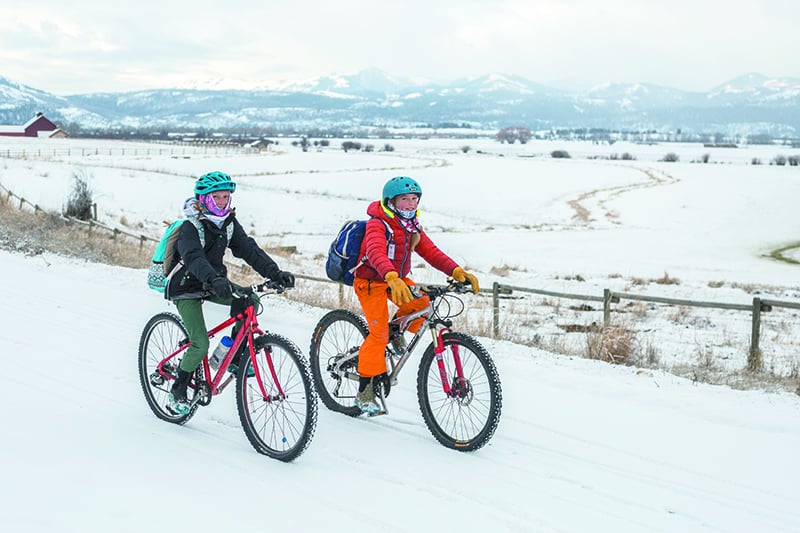
Sita Yeomans and Ruby Smith bike to school together two to three days a week. Photo by Ryan Dorgan
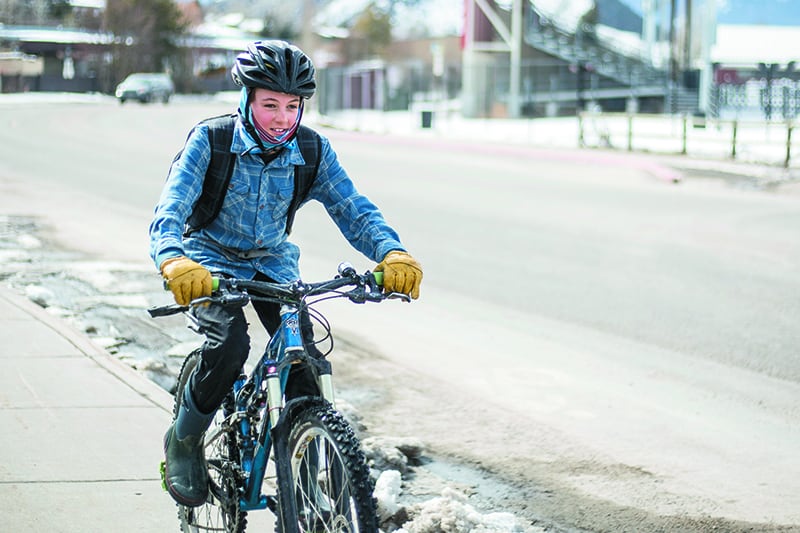
Oliver Smith. Photo by Ryan Dorgan
“I SET A goal in my brain that I was going to ride my bike to school every day,” says 11-year-old Ruby Smith. “Sometimes I think about wanting to take the bus, and then I remember I have this goal, and so I ride.” Ruby and her brother, Oliver, 12, ride from Rafter J to school and back home or to ski or bike practice Monday through Friday. They ride regardless of wind, rain, snow, or sleet. Their mother, Heather Smith, says there have been times when she looked out the window at sideways blowing snow and, knowing her kids were biking home in the storm, wondered if she was a bad mother for letting them ride in such conditions. “One time I actually got in the car and went to look for them,” she says. When Smith got to the kids, “Oliver looked at me and said, ‘What are you doing here?’ ”
TWO YEARS AGO, it was Oliver who first started commuting to school by bike. He’d been riding with the Jackson mountain biking team affiliated with the National Interscholastic Cycling Association and so was already on his bike all the time. It just made sense for him to keep riding, even if it necessitated finding a trailer that allows him to pull his French horn behind him on those days when he needs to practice at home. Ruby quickly jumped on board, although because she attends a different school from her brother, they usually don’t ride together. Oliver figures their commute comes out to about 4.5 miles a day. Over the 170-day school year they ride roughly 765 miles a year. This doesn’t include the additional miles Oliver puts in on his bike riding recreationally or training with the mountain bike team.
This past winter the kids did miss a couple of days. A ski injury kept Ruby off her bike for about one week. On the day after Jackson received 4 feet of snow in forty-six hours, massive snow drifts defeated Oliver. He pushed his bike home and got a ride to school. But once plows cleared the pathways, he was back on his bike. The kids don’t carry phones when they ride, but know how to ask for assistance if they need it—like the afternoon Oliver’s chain broke. “He’s pretty resourceful,” his mom says. “I don’t really worry.”

A Brief History of Mountain Biking in the Tetons
Mountain bikes got here long before mountain biking trails did.
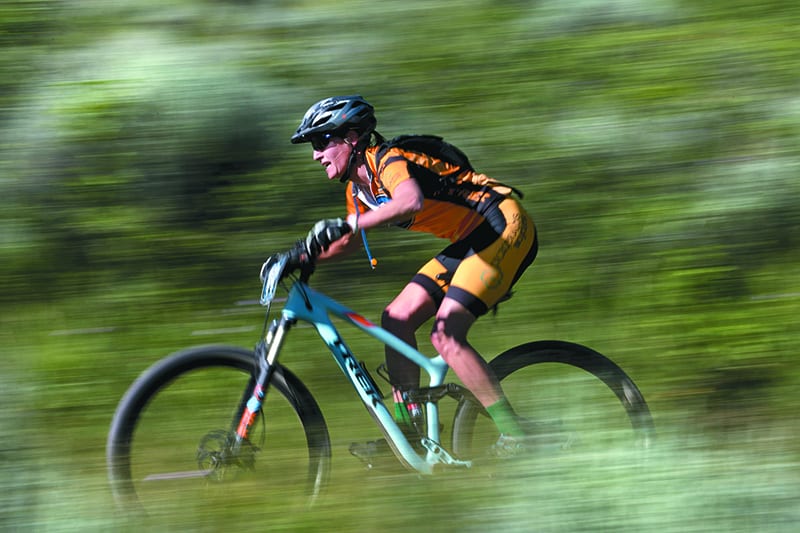
Erin Burnham speeds along single-track during the annual Cache Creek Mountain Bike Race. Photo by Rugile Kaladyte
“I MOVED TO Jackson in 1983, and there were a total of maybe three or four mountain bikes in town,” says Koehler, who still rides today and has been program director at FOP, a nonprofit bicycling advocacy group, since 2012. “We basically rode game trails.” About today’s riding, local mountain biker Paul Smith says, “The trails on Teton Pass are a huge part of why I live here.”
How did mountain biking in the Tetons get from game trails to great?
“Mountain biking started in Marin County, [California],” says Linda Merigliano, the recreation wilderness manager for the Bridger-Teton National Forest. “It came to Jackson in the ’80s. Ninety percent of the trails in the forest were closed to motorized use, but open to mountain biking. It was a free-for-all.” But the number of riders—and of forest users in general at that time—remained low so Merigliano says the impacts were negligible until the ’90s, when mountain bikes began to improve and more people began riding them. “We began to see bike tracks infringing into wilderness,” Merigliano says. “We started thinking, why not start developing trails outside wilderness so there would be no trespass?” In 2000, the BTNF signed an agreement with Friends of Pathways to begin community planning of bike trails. “We wanted to get people involved in stewardship—to be involved in taking care of their backyard,” Merigliano says. “We wanted to work with the community to decide what the trail system around Snow King would look like.” According to Merigliano, at that time trail design was a foreign concept and trail maintenance meant little more than clearing trees, but, with the growth of mountain biking, land managers recognized that in order to be sustainable, trails needed to be well-designed and well-planned. To guide its work, the BTNF adopted a motto: “Sustainable trails, respect for people, respect for land and wildlife.”
EARLY TRAIL-BUILDING efforts focused around Cache Creek and Snow King in East Jackson. But despite this development, mountain bikers—impatient with the limited number of options available—began constructing illegal, “pirate” trails in other parts of the Bridger-Teton and Caribou-Targhee National Forests, which include much of the public land in Jackson Hole and Teton Valley. “People were scratching in illegal trails to find new things to ride,” says Scott Fitzgerald, who, with wife Janine, founded the boutique bike shop Fitzgerald’s Bicycles in 2002. Because these trails were illegal, no one kept track of the number of miles built, but it was enough to create friction between riders and the national forests.
In 2004, the U.S. Forest Service brought together various groups to come up with a plan for trails on the Pass. At that meeting, Merigliano says they came up with the concept of separated trails—some for bikes, others for hikers and horses—to prevent conflicts, and decided to allow downhill trails to be developed if a nonprofit group agreed to take on maintenance. “We took a big risk,” she says. “We faced a lot of criticism. People felt like we’d condoned illegal activity by accepting some of the illegal trails, but it’s a two-way street. We accepted two trails and closed others. Teton Freedom Riders (TFR) was created to maintain the downhill trails. We developed hiking and horse trails. The model of Teton Pass is not going to work everywhere, but it has worked for us.”
A similar story unfolded a few years later in Teton Valley and the Caribou-Targhee National Forest. “Outlaw trail construction happened because mountain bike user groups felt like the forest service wasn’t providing enough use,” says Scott Bossell, the trail program manager for the Caribou-Targhee. “There are great opportunities in our ranger district due to the partnerships we have with Teton Valley Trails and Pathways (TVTAP), Mountain Bike the Tetons (MBT), and [Grand] Targhee,” Bossell says. “With the trails we’ve built up now, there is no longer a sense of urgency to get more miles built. Now we can relax and do the best job we can do. It’s better to make sure the trails are good than to build them fast. I’m excited to have the opportunity to create trails. In most places they are just trying to hang on to what they’ve got. We aren’t just trying to hang on thanks to the trail community we have here.”

Hit the Road
Our votes for the area’s most scenic road rides

Cyclists cruise along the pathway connecting Moose Junction to Antelope Flats. Photo by Bradly J. Boner
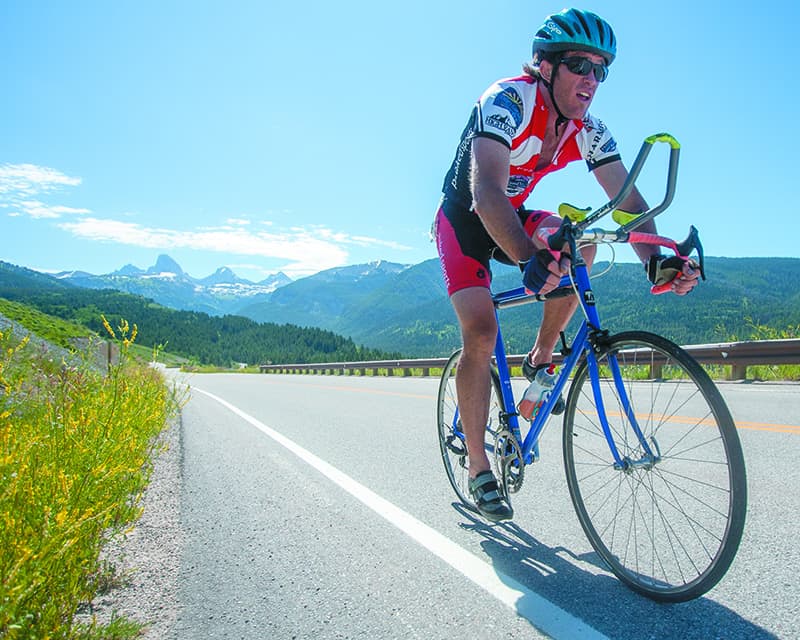
The ride from Driggs to Grand Targhee Resort climbs Ski Hill Road and offers fantastic Teton views. Photo by Travis J. Garner
1. DON’T PLAN ON doing the North Pathway and Grand Teton National Park pathway quickly: You’ll be stopping every few minutes to take a photo. This ride starts at the Greater Yellowstone Visitor Center in downtown Jackson, goes along the edge of the National Elk Refuge and past the National Museum of Wildlife Art. It eventually enters GTNP and passes through the tiny community of Moose before ending at Jenny Lake. If you ride it all the way from downtown to Jenny Lake, it’s 20 miles (one-way). If you’re not up for a 40-mile round trip, the ride to Jenny Lake from the Craig Thomas Discovery and Visitor Center (in Moose) and back is about 16 miles.
2. The 16-mile Antelope Flats Loop includes 11 miles on a little-trafficked road; the rest of the ride is on the North Pathway. Start at the Gros Ventre Junction and pedal east on Gros Ventre Road toward Kelly. Continue on the road as it swoops north at Kelly. Before it rejoins Highway 26/89 one mile north of Moose, the road passes Mormon Row and the famous Moulton Barn. Return to the start on the North Pathway.
3. Fall Creek Road is a classic out-and-back with a moderate amount of climbing. From downtown Jackson it’s 36 miles to the end and back. From Wilson it’s a 21-mile ride. The ride passes lush green hayfields, stands of cottonwoods, working ranches, exclusive subdivisions, grazing cattle, and riparian areas thick with willows. The farther you get from Wilson, the more rural things get, until finally, after a 2-mile climb up 700 feet, the road turns to dirt. At the top of the climb, catch your breath and then turn around and enjoy your prize: 2-miles of arcing turns back down to the flats.
4. The 26.8-mile rolling Cedron Loop through farmlands on the west side of Teton Pass offers impressive views of the Grand, Middle, and South Tetons along its entire length. Start in Victor and pedal north to Driggs on the bike path that parallels Highway 33. In Driggs, turn left (west) at the traffic light onto Bates Road. After several miles, the road arcs to the south and turns into S 5000 W. Continue along this road until it turns back to the east and becomes Cedron Road., which takes you back to Victor.
5.The climb to the base area of Grand Targhee from downtown Driggs (we recommend parking at Peaked Sports) on Ski Hill Road is 2,200 vertical feet and 12 miles. And it’s worth every ounce of effort. Just past the Wyoming state line and the small town of Alta, Teton Canyon opens up ahead, offering a jaw-dropping view of the Tetons’ high peaks … just as the climbing begins in earnest. (Still, unlike riding up Teton Pass, these grades rarely exceed 6 percent.) For the next 6-ish miles, you’ll wind your way up past open meadows, aspen glades, and spruce and fir forests, and then turn around for a fun, fast descent back to Driggs.

Electric Pedal
E-bikes are (almost) everywhere.
ACCORDING TO THE market research firm NPD Group, electric bike (e-bike) sales worldwide jumped 95 percent between July 2016 and July 2017. They now constitute a $65 million industry, and are changing the way people get around. “Ninety percent of e-bikes are used for commuting,” says Chris Borgert, the head mechanic at Jackson’s Hub Bicycles. “E-bikes are about car replacement, and with our traffic scene in Jackson, they are the way to go.”
E-bikes aren’t without controversy, though. Jackson resident John Clark wrote a Guest Shot in the Jackson Hole News&Guide in the spring of 2018 saying, “[E-bikes] are vehicles. They use a motor. They are motor vehicles. E-bikes are great but they belong in the slow-moving motor-vehicle lane.” Still, in 2018, the Teton County Board of County Commissioners and the Jackson Town Council voted to allow e-bikes on town and county pathways. E-bikes can also be ridden on any trails that allow motorized use. They are not allowed on GTNP pathways, on nonmotorized mountain bike trails, and in areas designated as wilderness.
Because e-bike classification is a gray area, especially as the bikes vary in terms of power and speed (but most max out at 28 mph), a county ordinance requires that e-bikes be inspected by Town of Jackson police before they can be ridden on pathways. It’s still too early to call the introduction of e-bikes onto pathways a resounding success, but, so far, it seems to be working. Still, Schilling told the News&Guide in May 2018, “This is not immutable. The electeds reserved the right to change
their policy in the future if e-bikes prove incompatible with pathway usage.”

The Long Haul
Jay Petervary rules at riding routes that are hundreds, sometimes even more than 1,000, miles long.
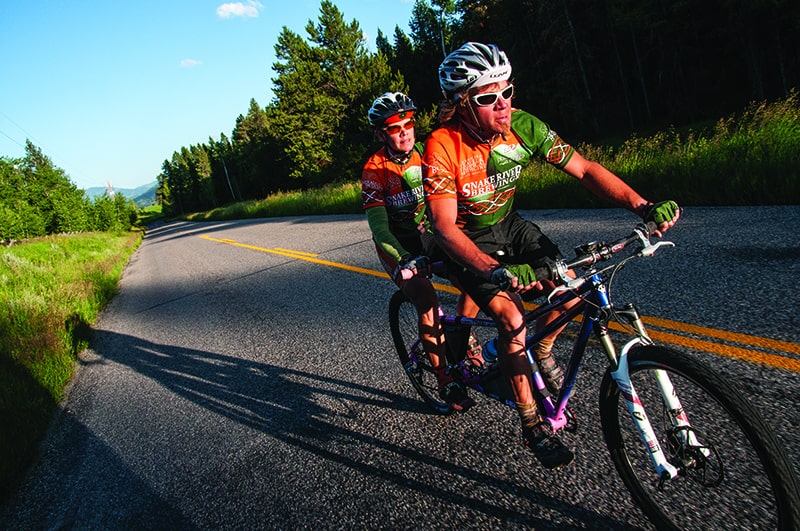
Endurance racers Jay and Tracey Petervary ride their tandem mountain bike on Fall Creek Road. Photo by Bradly J. Boner
AT 47, JAY Petervary is among the most decorated ultra-endurance bicyclists of all time. His list of championships and records is long. He’s won the 1,000-mile Iditarod Trail Invitational bike and endurance race, which follows the route of its more famous cousin, the Iditarod Trail Sled Dog Race, multiple times and is its current record holder (16 days, 23 hours and 53 minutes). He’s won the 2,490-mile Tour Divide Race eight times and Italy’s 560-mile Divide Race twice. In 2018, Petervary won the inaugural Silk Road Mountain Bike Race, a 1,050-mile ride in the mountains of Kyrgyzstan that included icy, thigh-deep river crossings, grueling climbs and frightening descents, mechanical failures, sickness, and unrideable sections where competitors hiked and carried their bikes. Oh, and temperatures ranged from 14 degrees to 90 degrees.
Petervary, who is married to fellow endurance racer Tracey, discovered his talent for pushing himself to extremes on his bike in 2007. Looking for something hard to do, he signed up for the Tour Divide, which follows the Continental Divide from Canada to Mexico. He didn’t really know what he was getting himself into, but had experience suffering and pushing himself: He’d been an adventure multisport racer for about a decade—competing in early Eco-Challenge events that included everything from biking to running, boating, rappelling, and navigation. He turned out to be a natural long-distance biker: He won and set a new record—15 days, 4 hours, and 18 minutes.
“The bicycle is my crutch,” Petervary said in an interview posted on the website of bike manufacturer Salsa, one of his long-time sponsors. “It’s where I develop my best ideas, get away, have fun, spend time thinking, solve world problems. It’s the one thing I do where I don’t do ten other things at the same time. It allows me to clear my head but also focus. … I learn a lot of life lessons from the bike.”
LONG-DISTANCE MOUNTAIN bike racing, aka “bikepacking” is a relatively young sport. The Tour Divide route was first mapped in 1997, and it wasn’t long before bikers, carrying camping gear, repair kits, and food, began informally racing each other from Canada to Mexico. The first Iditarod Trail Invitational was held in 2000. Since then more races have sprung up. But many of the classic races, including the Tour Divide, have no entry fees or prizes; they aren’t really even sanctioned events, but rather “friendly rides.” (Although there’s nothing particularly friendly about the level of competition.) Even the sanctioned races don’t offer much prize money to winners. A very few top riders like Petervary are sponsored by various companies. “Sponsorships have made it possible for me to brand myself so I can make a living—can eat and breathe bikes every minute,” he says.

Take it Easy
Our four favorite mellow(ish) mountain biking trails.
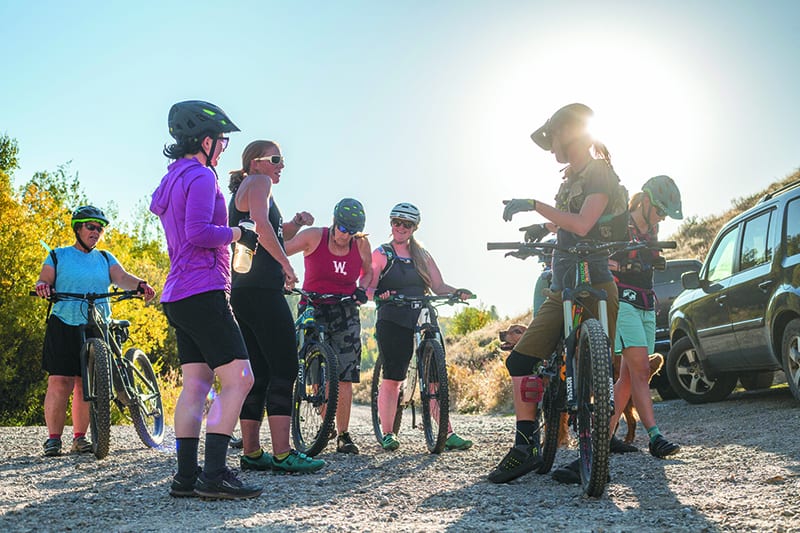
Jackson Hole Babe Force members meet for a ride up Game Creek. Photo by Ryan Dorgan
1. South of Wilson, Munger Mountain offers a figure-eight-shaped network of single-track trails that can be linked for a total of 8.4 miles. Also here? Some of the best Teton views in the valley, spectacular wildflowers (summer), and golden aspen groves (fall). A couple of stout climbs and some rocky sections along the Wally’s World trail give the network an intermediate rating, but most of the riding is fast, flowy, and fun.
To get there:From Wilson, turn south onto Fall Creek Road and take it for approximately 12 miles. At the top of a steep hill right before Red Top Meadows, you’ll see a parking pullout on the right (with a map of the trail network). Park here. The trail starts on the opposite side of the road.
2. The Southern Valley Recreation Project trail network is the dream child of the late, local bike rider and advocate AJ Linnell. Here you’ll find several miles of beginner/intermediate trails that roll through lodgepole forests, aspen groves, and open meadows, and have banked turns, ride-able, switchbacked climbs, and fast, flowy downhills. There aren’t any huge climbs, which makes the area popular with families.
To get there: Head west over Teton Pass. Just past the Idaho state line, turn left into the Mike Harris Campground, which doubles as the trailhead.
3. Voted the No. 2 Best Bike Park in the Northwest Region on MTBparks.com for three years running, Grand Targhee Resort has more than 70 miles of cross-country and downhill mountain biking trails, a bike patrol to assist riders, a skills practice area where you can try your hand at technical riding, group clinics, and private lessons. Trails are at all levels, from gentle, banked cruisers to tight, twisty single-track. Downhillers can bring their bikes up 2,200 vertical feet on a chairlift.
To get there:Drive west over Teton Pass on Wyoming Highway 22/Idaho Highway 33 to Driggs, Idaho. Turn right at Driggs’ only stoplight onto Ski Hill Road, which ends at Grand Targhee. It’s about a one-hour drive from downtown Jackson.
4. You can ride for one or four hours on the 46-mile network of single-track trails connecting Cache Creek, Game Creek, and Snow King Mountain. Ferrins, one of the first mountain bike trails built in the valley, is in this area, and while it climbs about 800 feet, it has a mellow grade and is in the shade. The Cache Creek Sidewalk Trail and Putt-Putt Trail are also beginner-friendly. Because of its proximity to downtown Jackson, expect to run into many other users (and dogs) in this area. Consider riding with a bell to avoid surprising others on the trails.
To get there:From downtown Jackson, take Broadway to Redmond Street. Turn right on Redmond and after about three quarters of a mile, a left onto Cache Creek Drive. The trailhead is at the end of Cache Creek Drive, less than 2 miles from its intersection with Redmond.




